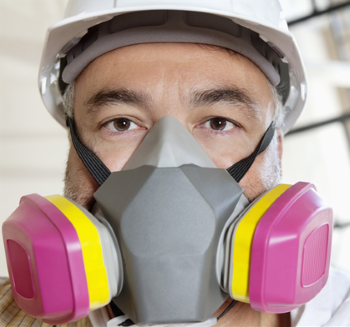Respiratory Protection & Workplace Injury Prevention
What would life be like if you felt like you could never fully catch your breath? If the simple act of breathing became more difficult with each passing day? Imagine having all of these symptoms after never having used a single tobacco product in your life. This is the reality that workers with silicosis face. They contracted silicosis as a result of their work, after breathing dangerous silica particles in the dusts from concrete and other stone products.
Silicosis is not the only respiratory disease that workers are exposed to, either. Asbestos exposures can lead to lung cancer and mesothelioma, and other inhaled particulates can lead to additional medical issues. Even chemical fumes and vapors can cause respiratory damage and disease. No one deserves to have this happen. Your duty is to ensure that your workers are properly protected from respiratory hazards.
Understanding Respiratory Hazards
Unfortunately, it is not easy to tell when a person might be exposed to dangerous amounts of a respirable hazard. You can’t look at a cloud of dust and know whether it exceeds the permissible exposure limit (PEL) established by OSHA. The exposure can only be measured through air sampling and laboratory testing. Now this doesn’t mean that your operations need to stop every time there is a cloud of concrete dust. When an employer has reason to suspect that employees may be exposed to amounts over the substance’s PEL, then a workplace injury prevention expert should be consulted to determine if air sampling is necessary.
Some other workplace exposures that may require respiratory protection are:
- Painting operations
- Welding/grinding/metal-working operations
- Working with silica-containing materials
- Working in confined spaces
- Chemical hazard exposures
- Dusts and nuisance dusts
- Smoke
Workplace Safety Management Programs To Protect Against Respiratory Hazards
What can employers do to protect their employees from respiratory hazards? The first line of protection should be to eliminate or minimize exposure to the hazard through engineering and administrative controls. For example, the recent Silica standards include specific engineering controls based on tasks performed to eliminate or reduce exposures.
Administrative controls also provide ways to minimize an employee’s exposure through employee scheduling and operational procedures. The last line of defense, as always, is personal protective equipment (PPE). PPE includes a variety of respirators that need to be specifically selected based on the exposures that employees will face.
Keep in mind that when your employees are required to wear respirators, either due to employer policy or to exposures exceeding the PELs, a written respiratory protection program must be in place. Workers must be trained on the plan and the respirator, including proper use, limitations, and proper maintenance of the respirator. A designated and qualified program administrator must oversee the respiratory protection program, and is responsible for evaluating the program’s effectiveness. All of this is to ensure the safety of our workers when they are exposed to potentially life threatening respirable substances.
Choosing The Proper Respiratory Equipment For Workplace Injury Prevention
An important part of the plan is understanding the different types of respirators that are available and choosing the right respirator for the exposures that our workers face.
The filtering facepiece respirator, also known as the dust mask, is the most basic form of respiratory protection. It provides the least amount of protection of all the respirators and protects employees from particulate exposures and nuisance dusts. If these are required, employees need to be trained to properly wear them and to check the fit of the masks. It’s also imperative that employees are provided with, and know to use, the correct type of dust mask. They need to have a NIOSH label, and must have two straps; the single strap varieties are not adequate.
The next level of respirator is the air purifying face fitting respirator. These form a seal with the user’s face, only allowing the user to breathe air that has passed through the respirator’s filters. Because of this, it provides considerably more protection than the dust mask. It can only filter out the particulates and substances that the filter is rated for, though. Before wearing this type of respirator, employees need to be medically cleared by a doctor, and need to be fit tested for the respirator before using it on the job. Fit testing needs to be re-evaluated annually, as well.
The most protective type of respirator is the air supplying variety. Instead of filtering the contaminants from the air, these respirators provide air to the user from a cylinder, tank, or pump. Because of this, employees are not exposed to the hazardous air at all, and only to the controlled air source. While they greatly increase the amount of protection they provide to workers, they also require the most training, the most maintenance, and are the most expensive. They are usually very bulky and awkward, too, which makes some types of work even more difficult for an employee to perform.
Workplace Safety Management Plans For Respiratory Protection
By now, it should be clear that respiratory protection is no small thing. It requires considerable time and effort to implement appropriately. This is an important point to communicate to your workers, too. By not following the requirements for a respiratory protection program, they can expose themselves to even greater hazards from using respirators incorrectly. Their improper use can also lead to OSHA citations for the company. This even includes having air purifying or air supplying respirators on a site where there is not a respiratory protection plan in place.
So make sure that your respiratory exposures are properly evaluated, and implement a workplace safety management plan respiratory protection program if needed. After all, it is your responsibility to ensure the safety and health of our employees.
Need help? Contact Optimum Safety Management to assist you with identifying respiratory hazards and develop and implement a workplace injury protection program.







